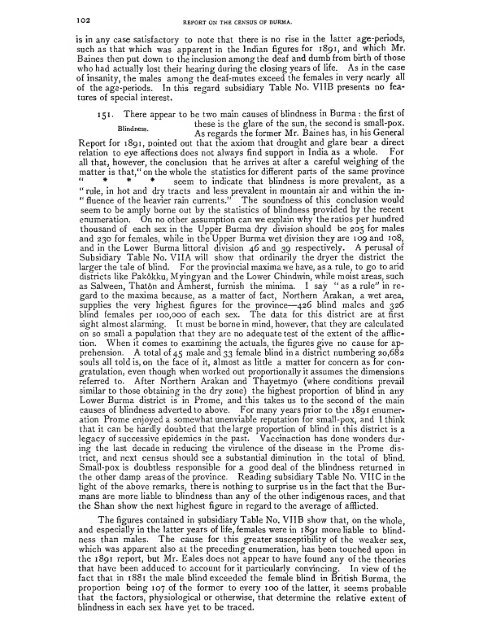Burma: Census of India 1901 Vol. I - Khamkoo
Burma: Census of India 1901 Vol. I - Khamkoo
Burma: Census of India 1901 Vol. I - Khamkoo
Create successful ePaper yourself
Turn your PDF publications into a flip-book with our unique Google optimized e-Paper software.
102 REPORT ON THE CENSUS OF BURMA.<br />
is in any case satisfactory to note that there is no rise in the latter age-periods,<br />
such as that which was apparent in the <strong>India</strong>n figures for 1891, and which Mr.<br />
Baines then put down to the inclusion among the deaf and dumb from birth <strong>of</strong> those<br />
who had actually lost their hearing during the closing years <strong>of</strong> life. As in the case<br />
<strong>of</strong> insanity, the males among the deaf-mutes exceed the females in very nearly all<br />
<strong>of</strong> the age-periods. In this regard subsidiary Table No. VI IB presents no features<br />
<strong>of</strong> special interest.<br />
151. There appear to be two main causes <strong>of</strong> blindness in <strong>Burma</strong> : the first <strong>of</strong><br />
these is the glare <strong>of</strong> the sun, the second is small-pox.<br />
c<br />
As regards the former Mr. Baines has, in his General<br />
Report for 1891, pointed out that the axiom that drought and glare bear a direct<br />
relation to eye affections does not always find support in <strong>India</strong> as a whole. For<br />
all that, however, the conclusion that he arrives at after a careful weighing <strong>of</strong> the<br />
matter is that," on the whole the statistics for different parts <strong>of</strong> the same province<br />
" * * * seem to indicate that blindness is more prevalent, as a<br />
" rule, in hot and dry tracts and less prevalent in mountain air and within the in-<br />
" fluence <strong>of</strong> the heavier rain currents." The soundness <strong>of</strong> this conclusion would<br />
seem to be amply borne out by the statistics <strong>of</strong> blindness provided by the recent<br />
enumeration. On no other assumption can we explain why the ratios per hundred<br />
thousand <strong>of</strong> each sex in the Upper <strong>Burma</strong> dry division should be 205 for males<br />
and 230 for females, while in the Upper <strong>Burma</strong> wet division they are 109 and 108,<br />
and in the Lower <strong>Burma</strong> littoral division 46 and 39 respectively. A perusal <strong>of</strong><br />
Subsidiary Table No. VILA will show that ordinarily the dryer the district the<br />
larger the tale <strong>of</strong> blind. For the provincial maxima we have, as a rule, to go to arid<br />
districts like Pakokku, Myingyan and the Lower Chindwin, while moist areas, such<br />
as Salween, Thaton and Amherst, furnish the minima. I say " as a rule" in regard<br />
to the maxima because, as a matter <strong>of</strong> fact, Northern Arakan, a wet area,<br />
supplies the very highest figures for the province— 426 blind males and 326<br />
blind females per 100,000 <strong>of</strong> each sex. The data for this district are at first<br />
sight almost alarming. It must be borne in mind, however, that they are calculated<br />
on so small a population that they are no adequate test <strong>of</strong> the extent <strong>of</strong> the affliction.<br />
When it comes to examining the actuals, the figures give no cause for apprehension.<br />
A total <strong>of</strong> 45 male and 33 female blind in a district numbering 20,682<br />
souls all told is, on the face <strong>of</strong> it, almost as little a matter for concern as for congratulation,<br />
even though when worked out proportionally it assumes the dimensions<br />
referred to. After Northern Arakan and Thayetmyo (where conditions prevail<br />
similar to those obtaining in the dry zone) the highest proportion <strong>of</strong> blind in any<br />
Lower <strong>Burma</strong> district is in Prome, and this takes us to the second <strong>of</strong> the main<br />
causes <strong>of</strong> blindness adverted to above. For many years prior to the 1891 enumeration<br />
Prome enjoyed a somewhat unenviable reputation for small-pox, and I think<br />
that it can be hardly doubted that the large proportion <strong>of</strong> blind in this district is a<br />
legacy <strong>of</strong> successive epidemics in the past. Vaccinaction has done wonders during<br />
the last decade in reducing the virulence <strong>of</strong> the disease in the Prome district,<br />
and next census should see a substantial diminution in the total <strong>of</strong> blind.<br />
Small-pox is doubtless responsible for a good deal <strong>of</strong> the blindness returned in<br />
the other damp areas <strong>of</strong> the province. Reading subsidiary Table No. VIIC in the<br />
light <strong>of</strong> the above remarks, there is nothing to surprise us in the fact that the <strong>Burma</strong>ns<br />
are more liable to blindness than any <strong>of</strong> the other indigenous races, and that<br />
the Shan show the next highest figure in regard to the average <strong>of</strong> afflicted.<br />
The figures contained in subsidiary Table No. VIIB show that, on the whole,<br />
and especially in the latter years <strong>of</strong> life, females were in 1891 more liable to blindness<br />
than males. The cause for this greater susceptibility <strong>of</strong> the weaker sex.<br />
which was apparent also at the preceding enumeration, has been touched upon in<br />
the 1 89 1 report, but Mr. Eales does not appear to have found any <strong>of</strong> the theories<br />
that have been adduced to account for it particularly convincing. In view <strong>of</strong> the<br />
fact that in 1881 the male blind exceeded the female blind in British <strong>Burma</strong>, the<br />
proportion being 107 <strong>of</strong> the former to every 100 <strong>of</strong> the latter, it seems probable<br />
that the. factors, physiological or otherwise, that determine the relative extent <strong>of</strong><br />
blindness in each sex have yet to be traced.

















